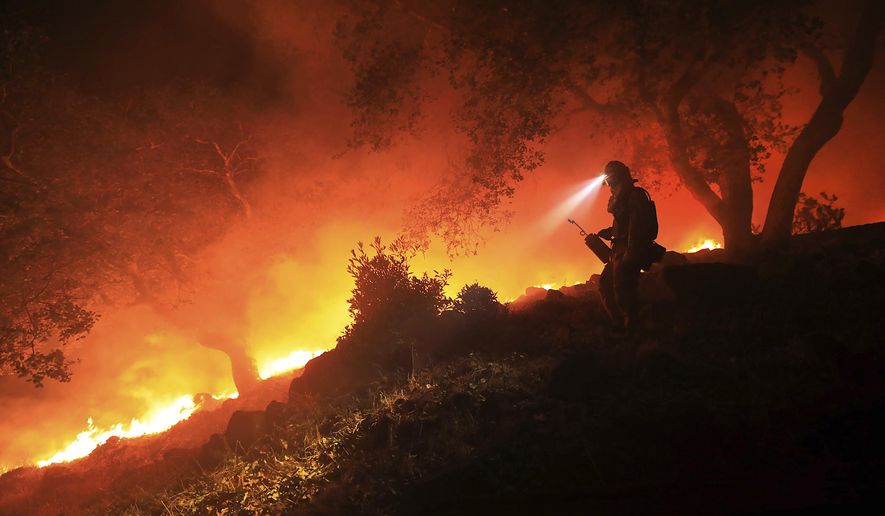At least 21 people have died and hundreds are missing as dozens of fires rage across Northern California, and officials expect conditions to worsen over the coming days as strong winds carry flames across a parched landscape rich with kindling.
“We’re not out of the woods, and we’re not going to be out of the woods for a great number of days to come,” California Fire Chief Ken Pimlott said during a press conference Wednesday afternoon.
“Make no mistake: This is a serious, critical, catastrophic event,” Chief Pimlott said, adding that he is concerned that several of the fires will merge into one conflagration.
On Wednesday morning, officials said 22 fires had burned 170,000 acres across Northern California, with the famed wine country of Napa and Sonoma counties the hardest hit.
Officials said the Atlas fire had burned 42,000 acres in Napa Valley, and the Tubbs fire in neighboring Sonoma had scorched 25,000 acres.
At least 11 people died in the Tubbs fire, making it the sixth-deadliest fire in the state’s history, according to fire officials.
Sonoma County Sheriff Rob Giordano said Wednesday afternoon that at least 380 people were missing, but he expects that number to drop as communication lines are restored and people are located after the chaos of evacuations.
At least 20,000 people have evacuated areas affected by the fires.
At least 3,500 homes and businesses were destroyed in the fires, and emergency declarations were made for the counties of Yuba, Butte, Lake, Mendocino, Nevada, Orange and Solano.
California Gov. Jerry Brown said the fires are the “biggest, most serious” event to occur in the state, and “it’s not over.”
“That’s the way it is with a warming climate, dry weather and reducing moisture,” Mr. Brown said during a press conference.
“These kind of catastrophes have happened and will continue to happen, and we have to be prepared to do everything we can to mitigate,” said the governor, a Democrat. “It’s going to cost a lot of money … along with the other ones in Texas, Florida and elsewhere, this will be tens of billions of dollars. We have to be ready to deal with this situation and prepare for others that will follow in the years to come.”
President Trump on Tuesday signed an emergency declaration for counties in California affected by the wildfires, which included 10 grants from the Federal Emergency Management Agency to supplement emergency costs and provide commodities of food, water, cots and blankets in addition to ground personnel associated with at least six federal agencies.
Mark Ghilarducci, director of the California Governor’s Office of Emergency Services, said at least 5,000 people -— including local, state, federal and military personnel — were responding to the fires. He said neighboring states Oregon and Nevada have offered to send people and services to help battle and contain the flames.
Acting Commissioner of Highway Patrol Warren Stanley said his team helped transport at least 80 people to hospitals Tuesday night and that patrol helicopters rescued 44 people, five dogs and two cats from Sunday night into Monday.
By late Tuesday, American Red Cross officials said they were sheltering more than 2,000 people. More are expected as evacuation orders continue and officials warn people against returning to their homes until early next week.
The fires began in earnest Sunday evening, officials said, and grew quickly in ferocity and scope because of hurricane-force winds, low humidity and ample kindling.
Jonathan Erdman, a senior meteorologist for Weather.com and The Weather Channel, said wildfires are particularly dangerous this time of year because of the combination of dry ground and strong offshore winds.
“Dry, strong offshore winds become more prevalent in October, which can quickly take a small brush fire and whip it into a destructive firestorm in a matter of minutes or hours,” Mr. Erdman said in an email to The Washington Times, adding that conditions are expected to worsen.
“Unfortunately, two more rounds of offshore winds are on tap, Wednesday night into Thursday, then possibly again Friday night into Saturday,” the meteorologist said. “While they aren’t expected to be as strong as the first intense round of winds responsible for the original firestorm, they will still be dangerous for both the existing fires and any new ones that may start.”
Sonoma County resident Maayan Lieberman said she was alerted to evacuate her home in Fountaingrove when a neighbor honked a car horn in the early hours of Monday.
“We left at four in the morning with just our pajamas and no socks. We ran for our lives,” said Ms. Lieberman, speaking by phone with The Times.
“We drove out of the house — the whole entire area was covered with fires — and drove through fires to get out. Everything was closed off, freeways were closed off. We drove on closed freeways,” she said. “There were maybe three or four cars total around us because many entrances were closed off, and on both sides we saw burning buildings. We drove over logs, there were flying logs, flying sparks and flames. We were very lucky to get out.”
Ms. Lieberman, a psychiatrist, said she is expected to report for work on Friday even though her hospital — Kaiser Permanente — is closed because of the fires.
“It’s a little ironic to have PTSD,” she said of her apprehension about returning to treat evacuees and people who have lost their homes and property.
Ms. Lieberman said that even though her house is still standing, all of her belongings have been ruined by the fire and smoke.
“Everything is gone. I have nothing to go home to,” she said.
• Laura Kelly can be reached at lkelly@washingtontimes.com.




Please read our comment policy before commenting.